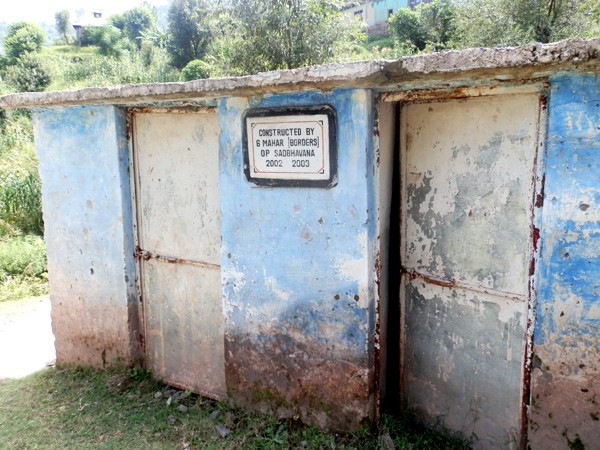Tazeem Akhter
On being asked upon about where do the school girls attend the natural call, eight-year old IrmNaz, with her blue eyes points to an isolated place murmuring “Utheyparre” (over there), referring to an open space, she identifies as toilet.
Turning eyes to the other side, one could spot at a distance three toilets which were constructed by the ‘6 Mahar Regiment’ under Operation Sadbhavana during 2002-03 that today stand in a dilapidated condition with their doors jammed. Another toilet, constructed recently under the ‘SarvaShikshaAbhiyan’ scheme, is locked as according to the three teachers present, there is no water-supply in the toilet.
Irm’s schoolmates, all dressed in blue uniforms begin to gather around her to share problems being faced by them in Government Middle School in Village Salotri – a neglected village along the zero-line in Poonch. The border district of Poonch known for the proximity of most of its villages to Line of Control (LoC) is situated 250 km away from Jammu – the winter capital of the Northernmost Indian State Jammu and Kashmir.
The issue of not having toilets as part of school’s infrastructure has implications more than meet the eyes. Besides affecting the health of the students, absence of toilets has become a major reason for parents to pull out their children, especially girls from schools as soon as they attain adolescence. Safia Begum, a mother of two girls enrolled in the same school laments, “Darr de hai, varusskekarrsaknehaan.” (We are too helpless to do anything.)
According to UNICEF, “Education for girls can be fostered by something as basic as a girls-only toilet.” The picture is quite imaginable, when the school is devoid of a toilet, let alone a separate toilet for girls. Only 43.1% of middle schools in the state have a girls-only toilet. Even for those parents who dare to educate their daughters at the cost of their security, fear is always there.
The fear that these parents risk for educating their girl child is “not worth it” as the quality of education too is a serious concern in these border villages. A majority of the parents withdraw their daughters from the schools as the teachers’ don’t take pain in teaching.
Mohammad Sagheer, a shopkeeper by profession doesn’t repent his decision of with drawing his nine year old daughter from school. “The teachers don’t do their duty. Only 2-3 teachers are present at a time, against the total number of eight teachers. She would better help her mother at home, and learn house-hold chores than to play all day at school.”
According to villagers the head-master comes only for 7-8 days in a month. The students of class 8th don’t know what ‘bangle’ means. This, despite the fact, that their English teacher had taught them the poem ‘The Bangle Seller’ the same day.
When the only teachers present are found to be busy gossiping over a corn-cob outside the classroom while students are busy playing cricket during school hours, one gets all the answers to the allegations made by the destitute parents. The state of education is very miserable, still lacking basic infrastructure, ridiculing vital RTE provisions.
However, the latest figures coming from Human Resource Development (HRD) Ministry depict that the state of Jammu and Kashmir, which witnesses a regular disruption also showed substantial improvements. The percentage at primary level rose from 78.5% in 2006-07 to 84.8% in 2012-13. Whereas, at upper primary level, an increase from 77.5% in 2006-07 to 88.5% in 2012-13 has been visible.
In this middle school, there were 19 girls and 42 boys present at the time of the visit. The enrollment register claimed the number of girls enrolled as 45, and the number of boys as 47. Whereas, according to a survey by District Information System for Education (DISE), the percentage of girls’ enrollment is 47.7% (2011-12). It is pertinent to mention here that female literacy rate of the state, is lagging at 58 %, much behind the male literacy rate of 78.3 %. ASER points out that the proportion of girls (age 11-14) not in school in Jammu & Kashmir has dropped encouragingly from 8.3 per cent in 2006 to 3.7 per cent in 2011, but rose again to 5 per cent in 2012. The proportion of girls in the higher age group (age 15 to 16) not attending school was a substantially higher 13.9 per cent in 2012.
Since there are no high schools in the proximity of these villages, girl students tend to drop out after appearing for their middle exams. “The nearest high school is in Jhalas which is six kilometers from Salotri towards Poonch town. Parents do not allow girls to travel this much distance alone because of security issues,” said twenty-one year old Shamshad who got married soon after appearing for her middle exams and is expecting her third child.
“If the government upgrades the middle school to high, the life of many girls won’t get spoilt like me.” Shamshad makes her point, “I’ll educate my daughter. This will make her self-dependent.”
Is anybody listening?
(The author is a final year student of Government Degree College, Poonch)
Charkha Features


